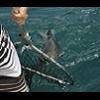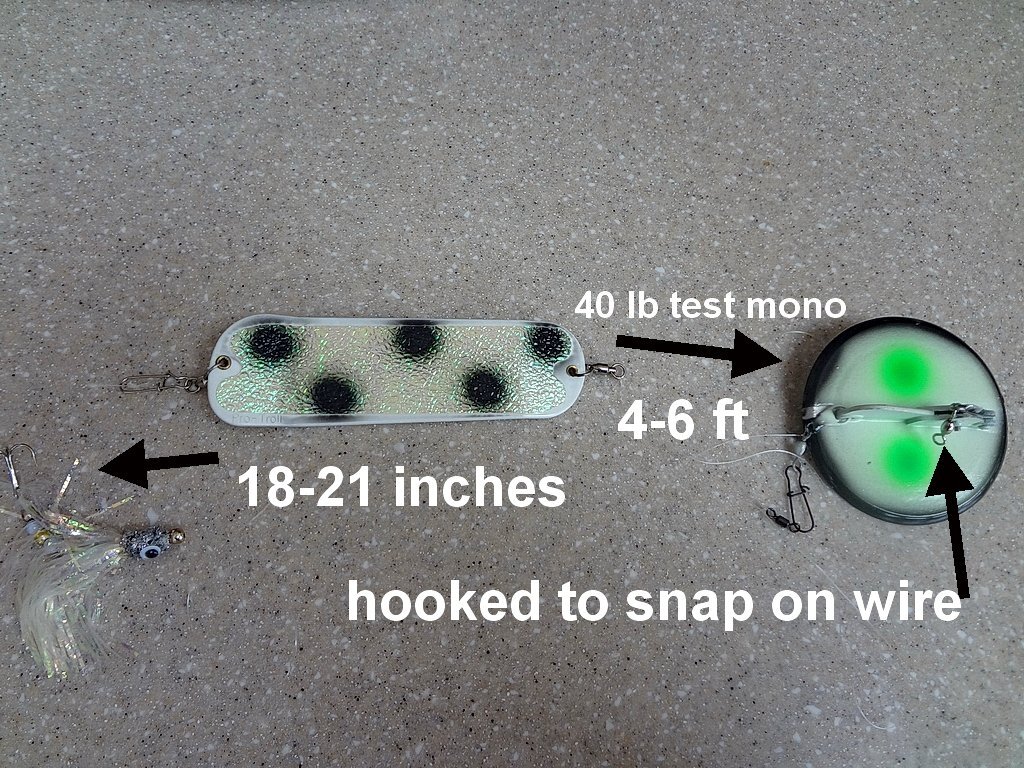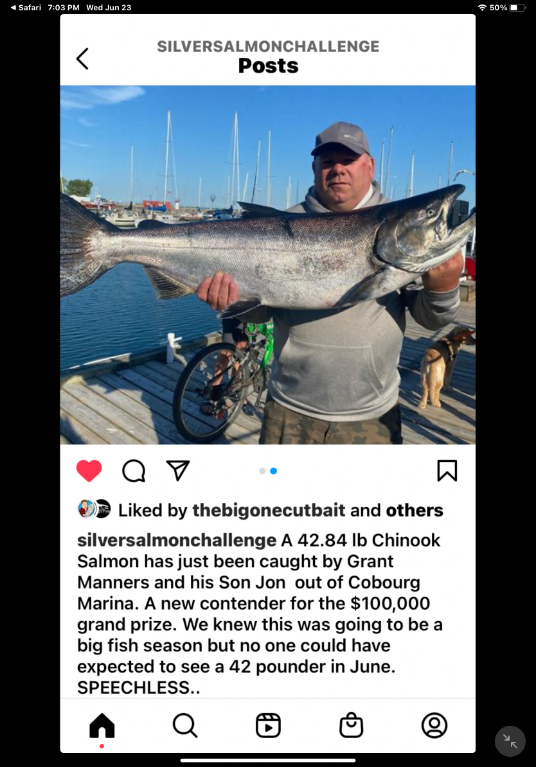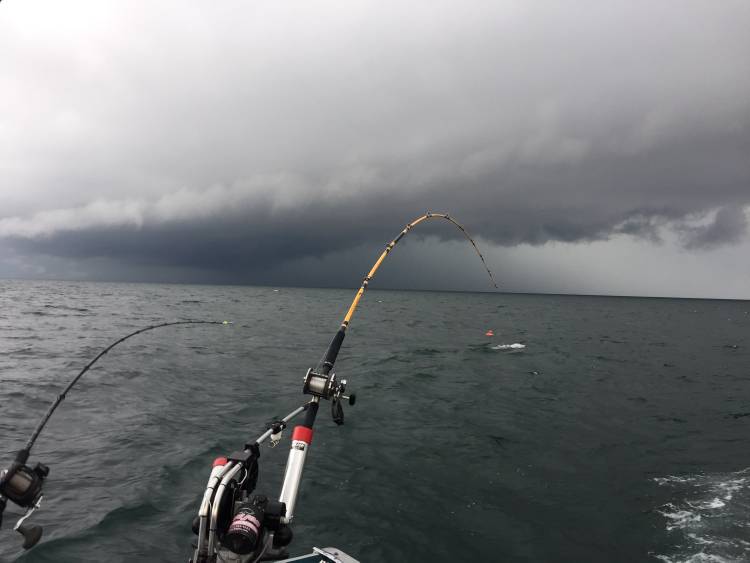-
Posts
1,526 -
Joined
-
Last visited
Content Type
Profiles
Forums
Events
Gallery
Store
Everything posted by TyeeTanic
-

Mono for divers/flashers
TyeeTanic replied to HoundsNTrout's topic in Questions About Trout & Salmon Trolling?
Yeah for sure. We often have 300 ft of wire out ... with mono, you'd never get to the same depth, even if you let out all 700 ft. You'd probably snap on a heavy torpedo weight to help with the depth, and have 400 ft of line out. Then when a nice fish takes out another 200' to 250' of line ... you'll start messing your underpants knowing you can see the bottom of the spool. Now, if you want to do shallow water fishing ... sure, you can put on a heavy torpedo and have say 150' to 200' out ... say target top 30' of water ... it might work ... still, I wouldn't want less than 400' to 500' of mono line on the reel. Everyway you look at it ... much better to have braid than mono, and even better to have wire, given the sink rate and smaller diameter (which allows you to put that much line on the reel, often 1000' is the go to length of wire on a reel). -

Mono for divers/flashers
TyeeTanic replied to HoundsNTrout's topic in Questions About Trout & Salmon Trolling?
What reel are you going to put a minimum of 700 ft of mono on? Not your old wire ones ... that's for sure. I'd much rather use braid then mono. You won't get good sink rate and you will have a heck of a time popping a dipsey when you have 200 ft or more of that mono line out. Anyhow, I think people use 20 lb mono, because there isn't a real around that could hold enough 30 or 40 lb mono ... at least not one that doesn't cost a fortune. -
-
Everything has it's challenges. Solar energy in the desert works, until the panels are coated in dust. Then you have to bring water into the desert to clean the panels ... plus no way to recycle solar panels, it is a major contaminant in landfills. Nuclear for now is the way to go ... minimal waste (although highly radioactive) ... but we can solve that with a deep geological repository ... or send capsules of waste to the moon.
-
Nuclear fission was not a "possibility" in the 1800's. Nuclear fusion will be possible in the near future. Sustainable fusion for 30 seconds long has been demonstrated just this past month. The event is held suspended by magnets, so the high temperature of the core is not in direct contact with any materials.
-
I wouldn't put boat in neutral if you have wire divers, copper, leadcore or riggers out ... you're for sure gonna bottom out those lines, unless you are fishing shallow lines in VERY deep water. Plus you don't know what the underwater currents are doing and whether they'll send the wire divers into the rigger lines ... just asking for big trouble, could cost a lot of money and time to fix that mess. Not worth it. Plus, more chance the fish spits the hooks, if not well set, and you go into neutral.
-
5 color, braid lead of say 6 ft, and another 5 color, then backing.
-
Outside diver (further from the boat) ... setting 3, less line out. Inside diver (closer to the boat) ... setting 1, and possibly even use a larger diver (mag). more line out. For example, inside might be 200 ft out, inside would be 150 ft out (higher in the water and further away). Reason. When the outside gets a hit, it will rise, and move to the center of the boat. If it is below (lower in the water) than the inside diver, it will cross into the inside wire, and tangle. If it is higher, it will just go over the inside wire.
-
So, there's two suggestions I can offer: 1) we tie a boca grip to a rope. When you're finished removing the hook, you clip the fish onto the boca grip and drop it into the water behind the boat, attached to the rope (which is tied to your boat cleat). You carry on, while the fish is "dragged" through the water by your boat (at 2 mph or so). This has an amazing revival rate, as fresh water is sent over their gills. When fish looks like it is fully active (takes about 2 to 3 minutes) ... pull the line in, release the boca, and good bye to a healthy fish. 2) in terms of the net, and avoiding bad tangle ups, I think one thing is to tie up the net material. I don't have an imagine of it, but see in this photo, how the guy is holding the net back onto the pole, you can do the same, except with a clip ... the clip is worthwhile when your net has a very long (often telescopic) pole. It prevents the net from draggin back towards the fish as the boat is still moving, and getting a nasty tangle up. Makes for a clean fish netting excercise ... and once the fish is in the net, the clip releases and the fish easily enters the center of the net. I used a magnetic latch to do this, one end hooked into the net, and the other end quick-tied to the post. https://www.walmart.ca/en/ip/Fly-Fishing-Magnetic-Net-Hanging-Buckle-Magnet-Net-Gear-Fishing-Tool/PRD0RQ764062OX4
- 1 reply
-
- 1
-

-
Just one point though, when you have a paddle on, drop the DR slower .... otherwise the paddle and line to bait get tangled.
-
I'd say majority of time spoons ... which also gives you an option to put on a free sliding cheater line. But for sure some guys put paddles on with meat/MC rocket, or flies. Start with the spoons, if they not working, then you can switch one up to paddle/bait.
-
Yeah I always used 30 lb big game, no issues, except for knots ... fleas would always grab there.
-
Normally DR for Great Lakes is run off 30 lb mono, mainly because line diameter is big enough that fleas don't hold onto and build up on line. I definitely wouldn't use braid. You could get away with 20 lb ... as long as you don't get flea build up.
-
Oh, I've made the same mistake lol, when someone was talking wire and didn't clarify it was for Walleye ... I wrote a story about 7 strand ... only to get a simple response ... NOT FOR WALLEYE FISHING! LOL.
-
A full spool of wire on our reels is 1000 ft ... you wouldn't do that without asking for a tangle mess, when you fish for salmon.
-
The backing (braid) is less important, but at that point, you'd have 100 ft to go. I definitely wouldn't risk letting out all the backing, and then something happens to that knot around the spool! LOL ... but yeah, you can dig say 50 ft into the backing, and then start reeling it all back in. Just make sure you do it at a steady speed so you have a nice even tension on the line always.
-
One thing to note. Once you fresh spool, a lot of clever guys will go out deep on their boats, and let out ALL that line with just a big paddle to create some tension/drag. If you're deep enough (300'), using only a dipsey is even better, as the paddle can twist the line if the swivel isn't great. Then they real it back in under that tension. You end up with the line seating way better ... because it's a nice constant tension, and can also take your time to make sure it seats from full side to side of spool. It also (with a good swivel) takes out any twist that may have been introduced during the fresh spool. No doubt, when I look at the before (on fresh spool) and after (let out and reel in) ... you can tell the wire is seated way better. In fact you will notice the wire is more compact and you could have probably added a little more backing!
-
So you have about 550 ft of wire left? I'd be tempted to spool up at least 300 ft of braid (I generally used 30# braid) ... if you can get 500 ft on there, even better. You rarely would have more than 250 ft of wire out anyhow, so that should work. It's just that with a big fish, you'll for sure see the backing spool out. I wonder if you can attach the braid on now ... with the 550 ft of wire still on the real, and just start spooling it on, until the reel is full, then transfer back to another similar reel? You would then end up with the braid under the wire, and you'd have the max amount of braid you can get on that reel.
-
As others state above, they are TWO different techniques. For wire dipsey, you want a 7 strand or 19 strand 30 lb line 1000 ft long. Attach the dipsey to the end of the wire, and add the tackle to the end of the dipsey... like paddle/fly or spoons. Weighted steel doesn't get a dipsey ... it's thicker diameter, heavy .... and sinks without the dipsey.
-

Best 2 copper set ups if you had to pick
TyeeTanic replied to Bassin Bob's topic in Tackle and Techniques
I would say 300 and 400, you'd be targeting 60' and 80' deep then. You can actually elevate that 300 line a bit higher too, by putting on a BIG paddle (creates more drag) ... that might get you to 50' ... it covers a lot of the water column that way, depending on your target depth. -
I'm more concerned about having the wire clipped at a certain point, and then you get bending back and forth due to wave action. Kind of like taking a wire in your hand and bending it back and forth, eventually it will snap.
-
Are you guys clipping the 19 strand onto the boards??? How do you avoid snapping the line from fatigue?
-
-

8 Rod Program Recommendation Needed Please!
TyeeTanic replied to ErieBuck's topic in Open Lake Discussion
There's guys that will tell you less is more. There are firm believers that having 8 lines in the water doesn't help you, it could actually hinder you. I think it is a matter of being versatile and seeing what the fish want. If the bite it hot, then sure 8 lines might work. If the fish are shy ... sometimes less is really more. -

Need some advice please!
TyeeTanic replied to WebsterWaters's topic in Questions About Trout & Salmon Trolling?
Note in your cable picture ... don't want to repeat, but for sure for a 12 lb weight that is WAY too much angle, your downspeed is definitely way too high. I wouldn't expect to see more than 20 to 30 degrees from a 12 lb weight. But note this ... you may see 20 degree into the water, but the cable then actually curves out (tending towards flat horizontal) the deeper and deeper it is in the water, so the overall angle is more than what your eyes can see. A 15 lb weight is obviously better .... but you really need to make sure your downrigger and gunwale can handle it ... over 12 lbs is getting into risky business. I've even seen gunwales flex with 12 lb weights ... wouldn't dare put 15 lbs on those boats. Doing the charter is a GREAT way to learn ... you will zero in on a lot, saving you lots of time and MONEY. I'm assuming you got yourself a good charter that can produce?






